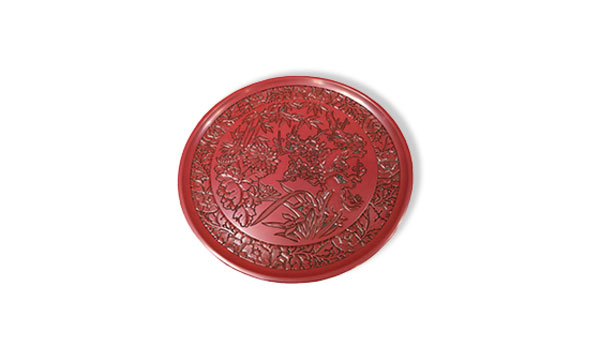
- Lacquerware
- Niigata
Murakami carved lacquerware Murakami kibori tsuishu
Grows in beauty with each use
Dynamic engravings and detailed patterns
Description
What is Murakami carved lacquerware ?
Murakami Carved Lacquerware (called Murakami Kibori Tsuishu in Japanese) is produced in the area around Murakami, Niigata prefecture. The region, which was formerly the Murakami domain, has been famous for its production of natural lacquer since the Heian period (794 - 1185). The beautiful craft involving elaborate engraving and durable, colourful lacquer finishing blossomed in this castle town. The characteristics of Murakami Kibori Tsuishu are its durability against daily use, and the way it gains a deep luster over the years it is used. This is not an art craft that is simply meant to be displayed and admired; the true value of Murakami Kibori Tsuishu can only be brought out through daily use. Tekko, the Chinese form of tsuishu which the Murakami Kibori Tsuishu was based on, involved engraving designs on thick layers of lacquer. In Murakami Kibori Tsuishu, however, engraving is done directly on the wood base before applying the lacquer coating, thereby reducing the amount of lacquer being wasted in addition to enabling artists to create dynamic engravings and detailed patterns. The articles are also extremely durable as they are coated several times with a viscous type of lacquer while avoiding lacquer from flowing into the grooves. Part of the production process includes delustering, which results in a matte finish that can be likened to light from a hazy moon, but the articles grow in gentle luster the more they are used.
History
It is said that a lacquer craftsman who came to Murakami from Kyoto to aid in the construction of a temple first started making Murakami Kibori Tsuishu approximately 600 years ago in the Muromachi period. The lords of the domain actively promoted the techniques during the Edo period, and a lacquer magistrate was established in the latter half of the 17th century, further boosting the cultivation of lacquer trees. The tsuishu (red lacquerware) and tsuikoku (black lacquerware) that we see today started to be produced in the 18th century. In the 19th century, the Murakami samurai warriors who worked in Edo began to pick up lacquering and lacquer carving techniques as a hobby, and contributed to the development of the industry when they brought these techniques home with them. The late Edo period saw the birth of a master craftsman, Shusai ARIISO (1809-1879). Born as the second son of temple carpenter Hachirobe INAGAKI, he was learning the family business under his father but his passion was wood sculpting. He went on to study sculpting in Edo along with lacquer arts, and acquired various techniques such as tsuishu and tsuikoku. By adding sketches of Chinese designs and incorporating Kamakura-bori techniques to improve quality, he laid the foundations of the Murakami Kibori Tsuishu that we see today.
General Production Process
- 1. Wood base production
Shapes of the articles are formed using well-dried wood from magnolia and Japanese horse chestnut.
- 2. Design
The wood bases are passed to the carver, who will draw designs of flowers, birds, landscapes and peonies on the wood.
- 3. Carving
The designs are then carved out using a chisel called urajiro.
- 4. Smoothing
The wood bases are passed to the lacquer craftsman, who will polish and smoothen the carvings with sandpaper so that the lacquer can be applied evenly. A grass known as horsetail was used in the past instead of sandpaper.
- 5. Wood hardening
A mixture of raw lacquer and red iron oxide is applied to fill up the fine holes in the wood in order to strengthen the durability of the tsuishu base. An undercoat is applied to the patterns and the surface is evened out.
- 6. Applying rust lacquer
A mixture of raw lacquer and polishing powder is applied 2 to 3 times on areas without any carvings.
- 7. Polishing the rust lacquered surface
The coated surface is wet sanded using a hard whetstone to remove any unevenness. This is carried out 2 to 3 times with the rust lacquering process.
- 8. Intermediate coating
An intermediate lacquer coat is applied. The lacquer is applied by dabbing with a pad (cotton wrapped in thin rubber) or fingertips to prevent the lacquer from filling up the grooves, and is subsequently finished with a brush.
- 9. Intermediate coat polishing
The non-carved surface and carvings are thoroughly wet sanded using a fine-grained Murakami whetstone.
- 10. Final coating
Vermillion lacquer is carefully applied using the same method used for applying the intermediate coat.
- 11. Delustering
The surface is evenly polished and delustered using charcoal and polishing powder.
- 12. Hairline engraving
The articles are returned to the carver, who will engrave patterns as fine as leaf veins on the delustered surface using a sharp triangular chisel.
- 13. Rubbing
The lacquer craftsman will then rub in high quality raw lacquer over the entire surface to tighten the surface coating, and the article is finally finished.
Where to Buy & More Information
Murakami-Kibori-Tsuishu Center
-
Address
-
Tel.+81-254-53-1745
-
Closedirregular holidays
-
Business Hours10am to 4pm
-
Website
See more Lacquerware
- Wajima lacquerware
- Kamakura-bori lacquerware
- Tsugaru lacquerware
- Aizu lacquerware
- Yamanaka lacquerware
- Kawatsura lacquerware
- Echizen lacquerware
- Joboji lacquerware
- Kiso lacquerware
- Hidehira lacquerware
- Kagawa lacquerware
- Ryukyu lacquerware
- Takaoka lacquerware
- Wakasa lacquerware
- Hida-shunkei lacquerware
- Ouchi lacquerware
- Kanazawa lacquerware
- Kishu lacquerware
- Kyo laquerware
- Odawara lacquerware
- Naruko lacquerware
- Niigata lacquerware
- Murakami carved lacquerware
See items made in Niigata
- Ojiya chijimi textiles
- Shiozawa tsumugi silk
- Hon-shiozawa silk
- Ojiya tsumugi silk
- Niigata lacquerware
- Kamo traditional chest
- Murakami carved lacquerware
- Tsubame-tsuiki copperware
- Echigo-sanjo cutlery
- Tokamachi traditional resist-dyed textiles
- Nagaoka Buddhist altar
- Tokamachi akashi chijimi textiles
- Echigo-yoita cutlery
- Sanjo Buddhist altar
- Niigata-shirone Buddhist altar































































































































































































































































































